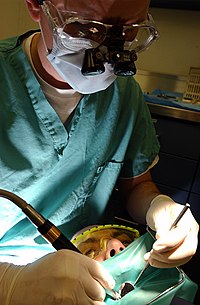Endodontics
This article has multiple issues. Please help improve it or discuss these issues on the talk page. (Learn how and when to remove these messages)
|
 An endodontist operating on his patient. | |
| Occupation | |
|---|---|
Occupation type | Specialty |
Activity sectors | Dentistry |
| Description | |
Education required | dental degree |
Fields of employment | Hospitals, Private Practices |
Related jobs | Oral and Maxillofacial Surgery |
Endodontics (from the Greek roots endo- "inside" and odont- "tooth") is the dental specialty concerned with the study and treatment of the dental pulp. Endodontists perform a variety of procedures including endodontic therapy (commonly known as "root canal therapy"), endodontic retreatment, surgery, treating cracked teeth, and treating dental trauma. Root canal therapy is one of the most common procedures. If the dental pulp (containing nerves, arterioles, venules, lymphatic tissue, and fibrous tissue) becomes diseased or injured, endodontic treatment is required to save the tooth. Endodontics is recognized as a specialty by many national dental organizations including the British General Dental Council, American Dental Association, Royal College of Dentists of Canada, Indian Dental Association, and Royal Australasian College of Dental Surgeons.
Training
USA
In the United States after finishing a dental degree, a dentist must undergo 2-3 additional years of postgraduate training to become an Endodontist. American Dental Association (CODA) accredited programs are a minimum of two years in length. Following successful completion of this training the dentist becomes Board eligible to sit for the American Board of Endodontics examination. Successful completion of board certification results in Diplomate status in the American Board of Endodontics. Although general dentists can perform endodontic treatment, there are several things which set endodontists apart. Endodontists use microscopes during treatment to better treat the small internal anatomy of teeth without taking away too much tooth structure, or causing iatrogenic damage. Also, endodontists use CBCT (3D imaging) to assess case difficulty and for diagnosis and treatment planning of endodontic cases. The overall dental care of patients is improved with an endodontist on the dental team.
Egypt
In Egypt, the students need at least 3 years of post-graduating programs (master's degree).
See also
- Root canal
- Regenerative endodontics
- Dental implant
- Endodontic therapy
- Journal of Endodontics
- Oral surgery
- American Association of Endodontists
- Ralph Frederick Sommer, an early developer of endodontics
References
This section is empty. You can help by adding to it. (January 2015) |
External links
Organizations
- American Association of Endodontists
- American Board of Endodontics
- British Endodontic Society
- Canadian Academy of Endodontics
- European Society of Endodontology
- International Federation of Endodontic Associations
- Indian Association of Conservative Dentistry and Endodontics
Publications
